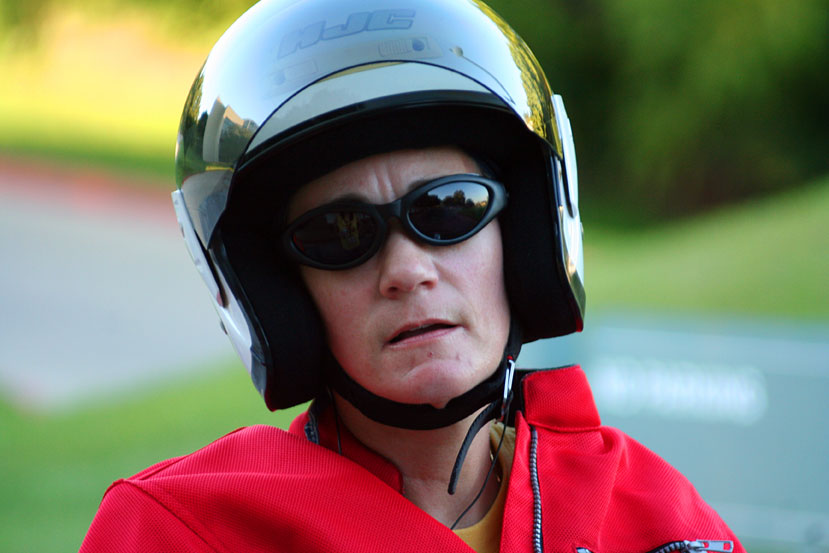
As moto crew chief for Lone Star Ride, Deanie Sewell takes her job of keeping cyclists safe very seriously
M.M. ADJARIAN | Contributing Writer
editor@dallasvoice.com
It takes all kinds of people — and all kinds of bikes — to make up a Lone Star Ride Fighting AIDS.
Most riders prefer bikes that are lightweight — lean and fast. But others prefer something with a little more heft and horsepower.
Deanie Sewell is one such participant. She wouldn’t dream of taking to the road on anything other than her Honda Shadow 750 motorcycle.
Sewell, an accountant, has been with the LSR as a member of the motorcycle — or “moto” — brigade since the ride began in 2001. She and her fellow bikers patrol the event route to ensure that their cycling counterparts travel in complete safety at all times.
“If bicyclists need help getting across an intersection, [the crew] will be their eyes looking behind them,” she says. “And if we see a rider out on the road having problems, we can usually stop and get to them quicker than a vehicle.”
 Sometimes, though, what’s called for is more along the lines of a pep talk. And brigade members are more than happy to slow down for a spell and oblige.
Sometimes, though, what’s called for is more along the lines of a pep talk. And brigade members are more than happy to slow down for a spell and oblige.
“You can ride right next to someone and give them a little encouragement,” says Sewell, who also serves as crew chief.
She adds, “Those cyclists really become your own; you get to know a lot of them out there, riding and watching out for them.”
Sewell knows very well how difficult cycling can be. She rode in the 1999 Texas Tanqueray AIDS Ride, a 300-plus-mile event that traveled across Texas and ended in Dallas.
“I rode all four days [of the TTAR] so I can say I did it. But after that, motorcycling was looking pretty good,” Sewell admits with a grin.
The moto crew chief and her merry band of bikers also help maintain route visibility. With cans of spray chalk carefully packed alongside the rest of their “road survival” gear, they make sure that all road markings — and especially the turns, which riders can easily miss — are clearly marked.
“We have a route-marking crew that goes out and marks the route,” Sewell explains. “After cars have driven over the chalk on the road, sometimes the markings can get a little faint. So we stop and re–mark them.”
Being able to cruise around for two days on her Honda in the company of other motorcycle enthusiasts is just one of the reasons Sewell loves her job. Another is being able to participate in the mass ride–in that closes each day of the event.
“On both days, we wait for the last rider,” Sewell says. “Then we follow that person in [with all kinds of] fanfare. And then on Sunday, the last day, we get into formation and, with horns honking and lights flashing, we bring all the riders in for closing ceremonies.”
Like so many other LSR volunteers, Sewell has compelling reasons for getting involved. She’s lost several close friends to AIDS and knows others who live with the disease.
“Most recently, I had another friend who moved back to Texas and who will be a client at the AIDS Outreach Center in Fort Worth. And I want to make sure that we can get additional funding that’s unrestricted and can be used for clients [like him],” she says.
What’s kept her coming back year after year, however, transcends any personal stakes she may have. For Sewell, the ride represents a manifestation of what’s possible when people put aside ego and selfishness and work together for a common purpose.
“‘If you are too busy judging people,’” says the moto crew chief, quoting Mother Teresa, “‘then you don’t have time to love them.’ And on this ride, there’s no judgment, there’s no us and them, there’s none of that at all.
“For two days, everybody is taking care of everybody else — and that’s just the way the world should be.”
Lone Star Ride Fighting AIDS takes place Sept. 24-25. For details or to donate to a specific rider or team or to the ride in general, go online to LoneStarRide.org.
















I have been a supporter of LSR for the last 10 yrs…mostly behind the scenes. However, I have never missed closing ceremonies, because to me, it is an amazing event with lots of compassionate and dedicated people, such as Deanie and hundreds of other volunteers. I get chills every time I watch the moto crew bring the riders in at closing; it is more often than not, a very emotional ending for an emotionally driven cause. Congrats LSR on 10 great years of helping our community affected by HIV/AIDS.
Deanie has consistently been one of the most positive, cheerful, hard-working and committed participants of LSR. Thank you so much for publishing the wonderful article about her.
Awwwww…..thanks Miss Janie! But, we wouldn’t be anywhere without you, and those with the vision and desire, to start up this event!!